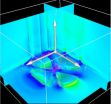(Press-News.org) In typical plasmonic devices, electromagnetic waves crowd into tiny metal structures, concentrating energy into nanoscale dimensions. Due to coupling of electronics and photonics in these metal nanostructures, plasmonic devices could be harnessed for high-speed data transmission or ultrafast detector arrays. However, studying plasmonic fields in nanoscale devices presents a real roadblock for scientists, as examining these structures inherently alters their behavior.
"Whether you use a laser or a light bulb, the wavelength of light is still too large to study plasmonic fields in nanostructures. What's more, most tools used to study plasmonic fields will alter the field distribution—the very behavior we hope to understand," says Jim Schuck, a staff scientist with Lawrence Berkeley National Laboratory (Berkeley Lab) who works in the Imaging and Manipulation of Nanostructures Facility at the Molecular Foundry.
Light microscopy plays a fundamental role in a scientist's repertoire: the technique is easy to use and doesn't inflict damage to a carefully crafted electronic circuit or delicate biological specimen. However, a typical nanoscale object of interest—such as a strand of DNA or a quantum dot—is well below the wavelength of visible light in size, which means the ability to distinguish one such object from another when they are closely spaced is lost. Scientists are now challenging this limit using 'localization' techniques, which count the number of photons emanating from an object to help determine its position.
In previous work, Schuck and colleagues at the Molecular Foundry, a U.S. Department of Energy (DOE) Nanoscale Science Research Centers, engineered bowtie-shaped plasmonic devices designed to capture, filter and steer light at the nanoscale. These nano-color sorter devices served as antennae to focus and sort light in tiny spaces to a desired set of colors or energies—crucial for filters and other detectors.
In this latest advance, Schuck and his Berkeley Lab team used their innovative imaging concept to visualize plasmonic fields from these devices with nanoscale resolution. By imaging fluorescence from gold within the bowtie and maximizing the number of photons collected from their bowtie devices, the team was able to glean the position of plasmonic modes—oscillations of charge that result in optical resonance—just a few nanometers apart.
"We wondered whether there was a way to use light already present in our bowties—localized photons—to probe these fields and serve as a reporter," says Schuck. "Our technique is also sensitive to imperfections in the system, such as tiny structural flaws or size effects, suggesting we could use this technique to measure the performance of plasmonic devices in both research and development settings."
In parallel with Schuck's experimental findings, Jeff Neaton, Director of the Molecular Foundry 's Theory of Nanostructured Materials Facility and Alex McLeod, an undergraduate student working at the Foundry, developed a web-based toolkit, designed to calculate images of plasmonic devices with open-source software developed at Massachusetts Institute of Technology. For this study, the researchers simulated adjusting the structure of a double bowtie antenna by a few nanometers to study how changing the size and symmetry of a plasmonic antenna affects its optical properties.
"By shifting their structure by just a few nanometers, we can focus light at different positions inside the bowtie with remarkable certainty and predictability," said McLeod. "This work demonstrates that these nanoscale optical antennae resonate with light just as our simulations predict."
Useful for researchers studying plasmonic and photonic structures, this toolkit will be available for download on nanoHUB, a computational resource for nanoscience and technology created through the National Science Foundation's Network for Computational Nanotechnology.
"This work really exemplifies the very best of what the Molecular Foundry is about," said Neaton, who is also Acting Deputy Director of Berkeley Lab's Materials Sciences Division. "Three separate Foundry facilities—Imaging, Nanofabrication and Theory—collaborated on a significant advance in our understanding of how visible light can be localized, manipulated, and imaged at the nanoscale."
INFORMATION:
A paper reporting this research titled, "Non-perturbative visualization of nanoscale plasmonic field distributions via photon localization microscopy," appears in Physical Review Letters and is available to subscribers online. Co-authoring the paper with Schuck, McLeod and Neaton were Alexander Weber-Bargioni, Zhaoyu Zhang, Scott Dhuey, Bruce Harteneck and Stefano Cabrini.
Portions of this work at the Molecular Foundry were supported by DOE's Office of Science. Support for this work was also provided by the National Science Foundation through the Network for Computational Nanotechnology.
The Molecular Foundry is one of the five DOE Nanoscale Science Research Centers (NSRCs), national user facilities for interdisciplinary research at the nanoscale, supported by the DOE Office of Science. Together the NSRCs comprise a suite of complementary facilities that provide researchers with state-of-the-art capabilities to fabricate, process, characterize and model nanoscale materials, and constitute the largest infrastructure investment of the National Nanotechnology Initiative. The NSRCs are located at DOE's Argonne, Brookhaven, Lawrence Berkeley, Oak Ridge and Sandia and Los Alamos National Laboratories. For more information about the DOE NSRCs, please visit http://nano.energy.gov.
Lawrence Berkeley National Laboratory is a U.S. Department of Energy (DOE) national laboratory managed by the University of California for the DOE Office of Science. Berkeley Lab provides solutions to the world's most urgent scientific challenges including sustainable energy, climate change, human health, and a better understanding of matter and force in the universe. It is a world leader in improving our lives through team science, advanced computing, and innovative technology. Visit our website.
Seeing the light: Berkeley Lab scientists bring plasmonic nanofields into focus
2011-02-05
ELSE PRESS RELEASES FROM THIS DATE:
Arctic fisheries' catches 75 times higher than previous reports: UBC research
2011-02-05
University of British Columbia researchers estimate that fisheries catches in the Arctic totaled 950,000 tonnes from 1950 to 2006, almost 75 times the amount reported to the United Nations Food and Agriculture Organization (FAO) during this period.
Led by Prof. Daniel Pauly, the research team from UBC's Fisheries Centre and Dept. of Earth and Ocean Sciences reconstructed fisheries catch data from various sources – including limited governmental reports and anthropological records of indigenous population activities – for FAO's Fisheries Statistical Area 18, which covers ...
Blood-clotting protein linked to cancer and septicemia
2011-02-05
In our not-so-distant evolutionary past, stress often meant imminent danger, and the risk of blood loss, so part of our body's stress response is to stock-pile blood-clotting factors. Scientists in the Molecular Medicine Partnership Unit (MMPU), a collaboration between the European Molecular Biology Laboratory (EMBL) in Heidelberg, Germany, and the University of Heidelberg Medical Centre, have discovered how stressed cells boost the production of the key blood-clotting factor, thrombin. Their work, published today in Molecular Cell, shows how cancer cells may be taking ...
Host or foreign -- the body's frontline defense mechanism understood
2011-02-05
This week, the highly-respected US Academy of Sciences journal (PNAS) published an article describing how the first line of defence of the human immune system distinguishes between microbes and the body's own structures. The basis of this recognition mechanism has been unclear since the key protein components were discovered over 30 years ago – and has now finally been cracked by a collaboration between high-level research groups at the University of Helsinki, Finland.
When a microbe has infected us, the first defence mechanism that attacks it is a protein-based marking ...
Review confirms benefits of outdoor exercise
2011-02-05
A systematic review carried out by a team at the Peninsula College of Medicine and Dentistry has analysed existing studies and concluded that there are benefits to mental and physical well-being from taking exercise in the natural environment. Their findings are published in the leading research journal Environmental Science and Technology today, 4th February 2011.
The research team, supported by the NIHR Peninsula Collaboration in Leadership for Applied Health Research and Care (PenCLAHRC, part of the NIHR family of health and research initiatives) in collaboration with ...
Petrol stations pollute their immediate surroundings
2011-02-05
In Spain it is relatively common to come across petrol stations surrounded by houses, particularly in urban areas. Researchers from the University of Murcia (UM) have studied the effects of contamination at petrol stations that is potentially harmful to health, which can be noted in buildings less than 100 metres from the service stations.
"Some airborne organic compounds – such as benzene, which increases the risk of cancer – have been recorded at petrol stations at levels above the average levels for urban areas where traffic is the primary source of emission", Marta ...
Scientific research reveals brain alterations linking omega 3 deficit with depression
2011-02-05
The link between deficits of omega-3 poly-unsaturated fatty acids (AGPO-3) and the onset of depressive disorders is not new in the medical field. However, what has not been known until now is the brain mechanism by which diet can condition mental health to a certain extent. Research undertaken by scientists in Bordeaux (France) and at the Faculty of Medicine and Odontology of the University of the Basque Country (UPV/EHU) and published in Nature Neuroscience, provides new clues to understanding this phenomenon.
The name of the research work, 'Omega-3 nutritional deficiencies ...
New images show cloud exploding from Sun ripples like clouds on Earth
2011-02-05
Physicists, led by a researcher at the University of Warwick, studying new images of clouds of material exploding from the Sun have spotted instabilities forming in that exploding cloud that are similar to those seen in clouds in Earth's atmosphere.
These results could greatly assist physicists trying to understand and predict our Solar System's "weather".
The researchers, led by of the Centre for Fusion Space and Astrophysics, at the University of Warwick's Department of Physics, made their discovery when examining new images of clouds of material exploding from ...
Sugar boost for Oxfordshire scientists who are planning ahead for future medicines
2011-02-05
Scientists continuing to investigate a 50 year mystery have discovered another vital clue that could help pave the way for improved medicines. The results feature in a special edition of Nature celebrating the International Year of Chemistry. The findings reveal an important insight into the way carbohydrates (sugars) bond and this will influence the way drugs are designed in the future.
Using specialist laser equipment from the EPSRC-funded Laser Loan Pool managed by STFC's Central Laser Facility, Professors John Simons and Ben Davis together with co-workers from the ...
Tipping points -- the future of the pharmaceutical industry
2011-02-05
This declining trend is blamed on a failure of innovative drive in the industry, failure of the UK to support basic research, failure of venture capital to invest in early stage research, or failure of the Health Service to provide smart procurement.
A research centre funded by the Economic and Social Research Council (ESRC) shows that radical reform of the drugs industry regulatory system must be an important part of the solution to ensure a productive and profitable pharmaceutical sector, both globally and in the UK.
Researchers from the ESRC's Innogen centre have ...
Massive Daphnia genome leads to understanding gene-environment interactions
2011-02-05
DURHAM, N.H. – From an environmental perspective, Daphnia pulex -- the waterflea – is the best-studied organism on the planet. Scientists know how this species responds to pollution, predators, day and night, making it an important model for ecological and evolutionary research. Its genome, however, remained elusive, limiting understanding of how the environment and genes interact.
Until now. An international team of researchers comprising the Daphnia Genomics Consortium, including four from the University of New Hampshire's Hubbard Center for Genome Studies, has described ...


